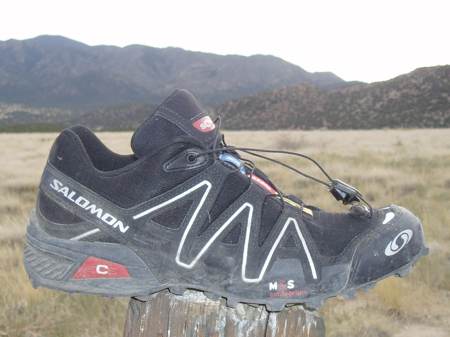For the latest on the Speedcross family, check out our Salomon Speedcross 6 review.
Our Favorite Trail Running Shoes
To learn about our current favorite trail running shoes, check out our Best Trail Running Shoes article.
Salomon Speedcross 2 Review
The Salomon SpeedCross 2 is a trail racing/training shoe that was first introduced in 2007 and continues to be a popular choice for many as a trail racing shoe. Salomon may have stumbled onto a very valuable lesson that shoe manufacturers never seem to abide by; if it isn’t broken, don’t fix it. With this review I hope to provide a comprehensive and unbiased look at the fit, performance, and durability aspects of this trail shoe. I have put about 200 miles on this shoe of trail running on a variety of different trail surfaces.
Salomon Speedcross 2 First Impressions
What I first noticed about this shoe is that it does fit true to size. The upper has a glove like feel to it that really straps the foot down making this shoe feel like a very natural extension of the foot. For its lack of weight, this Salomon comes in at about 11 oz. for my size 9.5. The shoes initially feels light and responsive, with a surprising amount of soft cushiness, especially in the heel. I tested the all black model which is striking in its appearance and is offset by the bright primary colored Salomon logo on the tongue. During one of my first runs in this shoe a friend remarked that they looked like the popular all-black 3/4 top basketball shoes from the 1990s. I took that to mean that they’re classic! Plus, we’re trail runners and we don’t really care anyway.
Salomon Speedcross 2 Outsole
The first thing I noticed about this shoe’s outsole was the absence of a rock plate. However, this absence was not accompanied by the usual bruising of my metatarsals. Instead, the outsole of the SpeedCross 2 is covered in chevron shaped lugs, made of a softer rubber composite than many trail shoes. These lugs seems to give the shoe much of its cushioned feel, and grip very well on just about any surface from rock, to mud, and sand. The outsole on the test shoes provided by Salomon were labeled “M&S Contagrip” and appeared to be exactly the same soles as others I saw in stores that said “Winter Contagrip”. I initially assumed the shoes labeled winter were the Gore-tex model, but I haven’t found any supporting evidence for that. What I find useful about this outsole is that it seems to extend and blend into the upper, giving the shoe a protective, but not bulky, surface around the midfoot that seems to be very durable. Salomon calls this a Mud Guard, and it did just that. Despite mountain runs on very muddy, clay-filled trails, the SpeedCross seemed to shed the mud and clay just as quickly as it accumulated. The synthetic rubber-like toecap on the front of the shoe also feels protective, but flexible, and kept water out of the shoe when stepping through puddles.
Salomon Speedcross 2 Midsole
The midsole of the SpeedCross 2 features quite a bit of cushion in the heel, and features dual-density foam on the medial (inside) of the shoe for pronation control. This chassis is aptly referred to as the Salomon Cushioning System an it provides a surprising amount of heel cushioning for a low profile trail racing shoe. Some minimalists may find this heel cushioning to be overkill, but I found it helpful when descending on rocky trail.
I’m a mid-foot striker with a little late stage pronation and I felt that the structural aspects of this shoe allowed it to support, but not impede, my stride and footfall. The heel to toe drop on this shoe is 10mm, fairly standard for most running shoes, but maybe a bit more than a lot “minimalist” trail shoes. The forefoot is flexible and feels nimble, especially when rock-hopping or running on scree, talus, or loose rock shards.
Salomon Speedcross 2 Upper
The upper of the SpeedCross fits very snug, especially in the mid-foot, due to the Salomon Quick-Draw kevlar lacing system. This lacing method took me a few tries to get it right, but once you get a feel for it the entire shoe tightens with one pull, slide the tab down to lock it in place, shove the tab up into the tongue pocket, and you’re good to go for miles. It really envelopes the foot but still allows your toes ample wiggle room and flexibility without any annoying fabric wrinkles that can cause blisters. My only gripe about the Quick-Draw lacing system is that after I shoved the tab into the tongue pocket I had difficulty fitting the rest of the excess lace in there with it. I ended up looping this excess lace around the lace eyelet closest to my toes to keep it from bouncing around during the run. Salomon could probably shorten these laces a bit and still have plenty of excess kevlar lace.
The heel collar of this shoe is well padded and snug, and worked well to keep rocks out even when wearing no-show running socks. The tongue is stitched into the shoe about half way and did not move throughout test runs. The entire upper is made of what Salomon refers to as Anti-Debris Mesh which I found to be extremely durable, but very slow to dry. Forays through creeks and runoff left the upper squishing as I ran for several miles and my feet felt pickled once I removed the shoes after my run. The SpeedCross also felt a bit hot to my feet, especially on runs above 80 degrees, but I think the thickness and protection of the anti-debris mesh would keep my feet warm in fairly cold weather.
Salomon Speedcross 2 Trail Running Impressions
My first run out of the box with these shoes turned out to be a 20 mile run on wet, technical mountain trails. The shoe felt very solid on ascents and equally in control while descending rocky terrain. The outsole is quite tacky and grips rock very well. Mud and clay did not get stuck on the sole which is very smooth between the well-spaced lugs. The shoes performed well on fire roads, gravel, and crushed gravel paths and the cushioning seemed suitable for use as light-weight trainers as well as trail racers.
Overall, the Salomon SpeedCross 2 is an excellently conceived and durably constructed trail shoe. My feeling is that Salomon has made a wise decision by not changing this shoe since its inception in 2007. This shoe would perform equally well on rocky Colorado mountain single track (where it was tested), as it would on the muddy, root-filled, rocky trails of the midwest or New England. I tested this shoe with a long technical trail run one weekend, and then wore them the following weekend in a trail 5k that ran up a dry, sandy creek wash. I would assume that they would perform equally well for fell running.
So, if you’re looking for a great all around trail racing/training shoe that is lightweight, as durable as they come, and will perform equally well in winter as in summer, look no further.
Call for Comments
Have you hit the trails in the SpeedCross 2? If so, let us know how it went. If you’ve got questions, fire away.
Contest
You know that we like to hook our readers up. That’s why we’re giving we gave away a pair of Speedcross 2 compliments of Salomon. (Thanks, guys!) Kristin Zosel was the lucky winner!
[Disclosure: Salomon provided the author with a sample pair on Speedcross 2 to review. In addition, the Amazon link in this post is part of an affiliate program that helps support iRunFar.com.]



